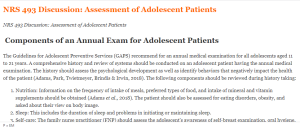NRS 493 Discussion: Assessment of Adolescent Patients
Sample Answer for NRS 493 Discussion: Assessment of Adolescent Patients Included After Question
Components of an Annual Exam for Adolescent Patients
The Guidelines for Adolescent Preventive Services (GAPS) recommend for an annual medical examination for all adolescents aged 11 to 21 years. A comprehensive history and review of systems should be conducted on an adolescent patient having the annual medical examination. The history should assess the psychological development as well as identify behaviors that negatively impact the health of the patient (Adams, Park, Twietmeyer, Brindis & Irwin, 2018). The following components should be reviewed during history taking:
- Nutrition: Information on the frequency of intake of meals, preferred types of food, and intake of mineral and vitamin supplements should be obtained (Adams et al., 2018). The patient should also be assessed for eating disorders, obesity, and asked about their view on body image.
- Sleep: This includes the duration of sleep and problems in initiating or maintaining sleep.
- Self-care: The family nurse practitioner (FNP) should assess the adolescent’s awareness of self-breast examination, oral hygiene, and the importance of regular exercises (Adams et al., 2018).
- Relationship with family members: This component helps identify the type of bond the patient has with the parents, guardians, and siblings.
- Peers: Information should be obtained on intimate friends and if the patient is involved in group or gang activities.
- School: The FNP should seek information on school attendance, performance, and the extra-curricular activities the adolescent takes part in school.
- Substance use: History should be taken on cigarette smoking, alcohol consumption, and drugs abuse (Adams et al., 2018).
- Sexuality: The FNP should ask the patient whether he or she is sexually active, and further enquire on use of contraceptives, and history of pregnancies and sexually transmitted infections (Adams et al., 2018).
During the physical examination, the mother will not be required to be present as it may be uncomfortable for the adolescent patient. However, I will enquire from her on developmental milestones, unusual behaviors she has observed, and if she suspects substance abuse.
A Sample Answer For the Assignment: NRS 493 Discussion: Assessment of Adolescent Patients
Title: NRS 493 Discussion: Assessment of Adolescent Patients
Health Promotion
For a middle adolescence patient, I will provide health education on promoting hygiene. Middle adolescence stage is characterized by adolescents refusing to bathe and staying in untidy rooms, and this puts them at risk of acquiring diseases such as fungal infections (Lahme, Stern, & Cooper, 2018). I will emphasize the importance of maintaining good personal hygiene by taking a shower daily, oral care, and putting on clean clothes. Furthermore, for an adolescent girl, I will stress on having a bath at least twice a day, regular change of tampons, and the proper disposal of tampons during menstrual periods (Lahme, Stern, & Cooper, 2018). This will help prevent body odors, prevent infectious diseases, and promote healthy living among the patient and confidence.
Click here to ORDER an A++ paper from our MASTERS and DOCTORATE WRITERS: NRS 493 Discussion: Assessment of Adolescent Patients
In the situation where I suspect drug and alcohol abuse, I will use the Brief Screener for Tobacco, Alcohol, and Other Drugs (BSTAD). The tool is administered to the patient or used for interviewing by the clinician and facilitates in identifying the use of alcohol, tobacco, or bhang (Kelly et al., 2014). It further enquires on the frequency of substance use in the past years. The frequency of use is categorized into three classifications, which include: no use, low risk and high risk (Levy et al., 2014). Additionally, I will use the CAGE questionnaire, which elicits information on alcohol and substance abuse from adolescents and their parents (Basu, Ghosh, Hazari & Parakh, 2016). Besides, the tool also helps in initiating discussions with adolescents on their perception of drug and alcohol use.
Discussion Questions
The discussion assignment provides a forum for discussing relevant topics for this week based on the course competencies covered.

For this assignment, post an initial response to all of the questions in the Discussion Area by Saturday 2300 Mountain Time. You must respond to two of your classmates\’ postings for this discussion.
To support your work, use your course and text readings and also use the South University Online Library. As in all assignments, cite your sources in your work and provide references for the citations in APA format.
Start reviewing and responding to the postings of your classmates as early in the week as possible. Respond to at least two of your classmates\’ initial postings. Participate in the discussion by asking a question, providing a statement of clarification, providing a point of view with a rationale, challenging an aspect of the discussion, or indicating a relationship between two or more lines of reasoning in the discussion. Cite sources in your responses to other classmates. Complete your participation for this assignment by the end of the week.
You are a Family Nurse Practitioner working in a community health center. You are seeing a 14-year-old adolescent patent for an annual visit. The patient’s mother is also present during the visit and notes that the patient’s grades in school have been declining. Her son is also hanging out with a group of kids that she has concerns about. The mother has concerns for what is going on with her son. Answer the following questions using course resources (texts) and two other evidence-based sources (current guidelines and/or scholarly articles that are within a 3-5 year time frame).
1. What are the components of an annual exam for an adolescent patient?
2. Is the mother required to be present during your exam?
3. Describe 1 health promotion idea that you would discuss with your middle adolescence patient. Why is this idea important?
4. What are some screening tools that might be of importance in this situation? (hint: do you suspect drug or alcohol abuse here?

